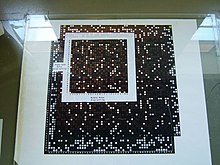Female (cryptology)
As a female (plural: Females , in the Polish original: samica or colloquially: samiczkami , German literally: "Weibchen" , German technical term: "one cycle" , occasionally, but less precisely: "Fixed point" ) is used in cryptology , especially in context with the cryptanalysis of the German rotor key machine Enigma , a repeated occurrence of an identical ciphertext-plaintext letter pair that can be used for deciphering .
The Bletchley Park 1944 Cryptographic Dictionary formatted by Tony Sale defines female as "The same constatation occurring at two different positions", thus as a text pair that occurs again in two different places (the text pair formed from the present ciphertext and the crib , i.e. the presumed plain text fragment) identical pair of letters.
Procedure
The basis of the "females" at Enigma was the German procedural error of duplicating the key to the verdict . This created ciphertext-plaintext letter patterns of the form "123123", which the Allied code breakers were able to use to break the machine. The Polish cryptanalyst Marian Rejewski recognized this as early as 1932 and used it together with his colleagues Jerzy Różycki and Henryk Zygalski in the Polish cipher office, the Biuro Szyfrów (abbreviation BS), to open up the Enigma keys used by the Germans . For this purpose, special perforated sheets were used, which had been invented by Zygalski, and from 1939, after the Pyry meeting , were also used by the British codebreakers in Bletchley Park ( BP ) in England (see also: Concept of the Zygalski perforated sheets ). They were further developed in BP by the British, whereby the effect of two rotating Enigma rollers was taken into account together with the reversing roller , and called "Jeffreys sheets" after the British codebreaker John Jeffreys .
By dropping the duplication of the slogan key on May 1, 1940 (ten days before the start of the western campaign ), the Allies lost this possibility of breaking into Enigma radio communications. As Gordon Welchman put it: "Our" females "were lost to us."
Word origin
According to Friedrich L. Bauer , the term originally comes from the Polish play on words te same ("the same") and samiczka ("female"), which was translated into English and thus became female . Gordon Welchman has the analogy between a hole in the perforated sheets out, can shine through the light of the light table, and the socket (English: female socket ) of an electrical outlet .
literature
- Friedrich L. Bauer : Deciphered Secrets. Methods and maxims of cryptology. 3rd, revised and expanded edition. Springer, Berlin et al. 2000, ISBN 3-540-67931-6 .
- David Link: Resurrecting Bomba Kryptologiczna - Archeology of Algorithmic Artefacts, I. , Cryptologia , 33: 2, 2009, pp. 166-182. doi : 10.1080 / 01611190802562809
- Gordon Welchman : The Hut Six Story - Breaking the Enigma Codes . Allen Lane, London 1982; Cleobury Mortimer M&M, Baldwin Shropshire 2000, ISBN 0-947712-34-8 .
Individual evidence
- ↑ a b Friedrich L. Bauer: Deciphered secrets. Methods and maxims of cryptology. 3rd, revised and expanded edition. Springer, Berlin et al. 2000, p. 49.
- ↑ Michael Miller: Symmetrical Encryption Methods - Design, Development and Cryptanalysis of Classic and Modern Ciphers . Springer-Verlag, 2013, p. 63. ISBN 3-519-02399-7 .
- ↑ The Bletchley Park 1944 Cryptographic Dictionary formatted by Tony Sale. Bletchley Park, 2001, p. 37. Retrieved March 14, 2016. PDF; 0.4 MB
- ^ Hugh Sebag-Montefiore: Enigma - The battle for the code . Cassell Military Paperbacks, London 2004, p. 357. ISBN 0-304-36662-5 .
- ^ Friedrich L. Bauer: Decrypted Secrets, Methods and Maxims of Cryptology . Springer, Berlin 2007 (4th edition), p. 123, ISBN 3-540-24502-2 .
- ^ Gordon Welchman: The Hut Six Story - Breaking the Enigma Codes . Allen Lane, London 1982; Cleobury Mortimer M&M, Baldwin Shropshire 2000, p. 97. ISBN 0-947712-34-8 .
- ^ Gordon Welchman: The Hut Six Story - Breaking the Enigma Codes . Allen Lane, London 1982; Cleobury Mortimer M&M, Baldwin Shropshire 2000, p. 231. ISBN 0-947712-34-8 .
